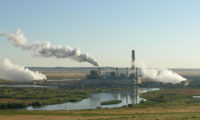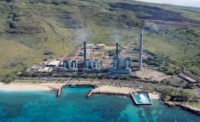"Black and Veatch has developed an integrated project schedule to provide overall coordination on the project," says Babcock & Wilcox project manager Fred Owens.
An unfettered site is helping with logistics, including the delivery and assembly of environmental components. "Sites for projects like this can get pretty congested. This one is fairly spacious," says Pieschl, adding that some environmental components, including pumps and ash-handling equipment, were prefabricated prior to arriving on site.
"All deliveries are by truck," says Owens. "There's a dedicated site off to the side of the plant where all materials are being delivered."
At present, two of five large cranes are assisting in the placement of ductwork, while another is engaged in the installation of the lime-preparation facility. The other two rigs are involved in the erection of four 130-ft-high spray dryers, two of which are nearing completion as crews lay carbon-steel panels atop structural steel. Workers are installing the 8-ft by 16-ft panels in rings, following the cylindrical profile of the dryers until they return to their starting point. Once a ring is complete, they begin work on another atop it.
Work on the first two dryers began in September. Once they are completed, crews will begin work on the second pair, with one set dedicated to Columbia 1 and the other to Columbia 2. After being brought online, the spray dryers will remove SO2 from flue gas generated by the plant with a high-speed rotary atomizer introducing a slurry of lime, recycled ash and water to the dryer to capture it. Further downstream, the pulse-jet fabric filter will capture by-product and particulate in the flue gas.
"Each compartment of the fabric filter captures by-product, which is collected in hoppers and either recycled back to the lime and fly ash system or sent to a waste fly ash silo," says Owens.
The new carbon-injection system will infuse carbon particles into plant exhaust, then channel the exhaust to a baghouse, where it will be collected in cloth bags that absorb mercury content prior to its release into the atmosphere. The system has been compared to the air filter in an automobile.
WP&L currently has a carbon injection system in place that reduced mercury emissions at Columbia by about 25%, from 627 lb to 482 lb, between 2009 and 2010, according to plant reports. Once the second unit comes online, WP&L will reduce mercury emissions to a fraction of that. SO2 emissions will decline to 2,700 lb a year from 27,700 lb.
Meeting more stringent regulations will allow WP&L to satisfy growing demand for power in the region, says David DeLeon, director of strategic projects with Madison-based Alliant Energy, owner of Wisconsin Power & Light. At present, Columbia 1 and 2 collectively generate 1,023 MW of electricity a year.
As work progresses, a current priority involves completion of the electrical building, owing to the large amount of conduit flowing to and from the structure.






Post a comment to this article
Report Abusive Comment